Family : Serranidae

Text © Giuseppe Mazza

English translation by Mario Beltramini
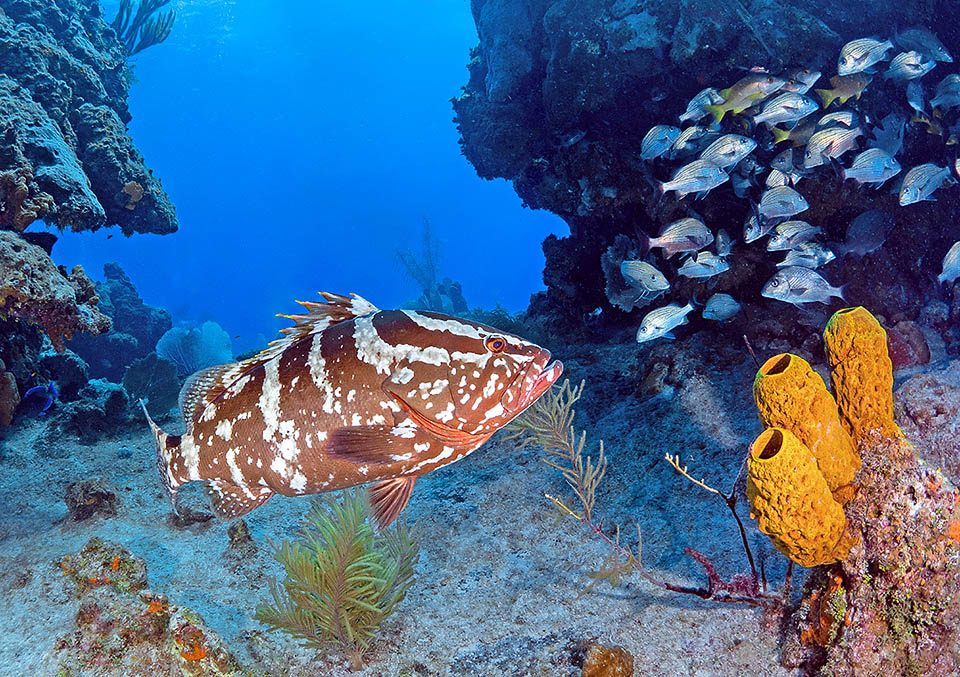
Fished for years with no scruples in its reproductive gatherings Nassau grouper (Epinephelus striatus) is now “Vulnerable” in the Red List IUCN of endangered species © Brian Cole
Epinephelus striatus (Bloch, 1792) known as Nassau grouper, fom the name of the capital of the Bahamas that belong to its range, belongs to the class of the Actinopterygii, the ray-finned fishes, to the order of the
Perciformes and to the family of the Serranidae.
The genus Epinephelus originates from the Greek “epinefes”, cloudy, with reference to the mimetic drawings often indefinite and changing of these fishes, whilst the specific term striatus, streaked in Latin, refers to its 5 characteristic transversal bands on the sides.
It is a grouper friend with the divers, probably the least suspicious among all groupers, that lets to be approached, like, after all, Epinephelus marginatus, once common in the Mediterranean.
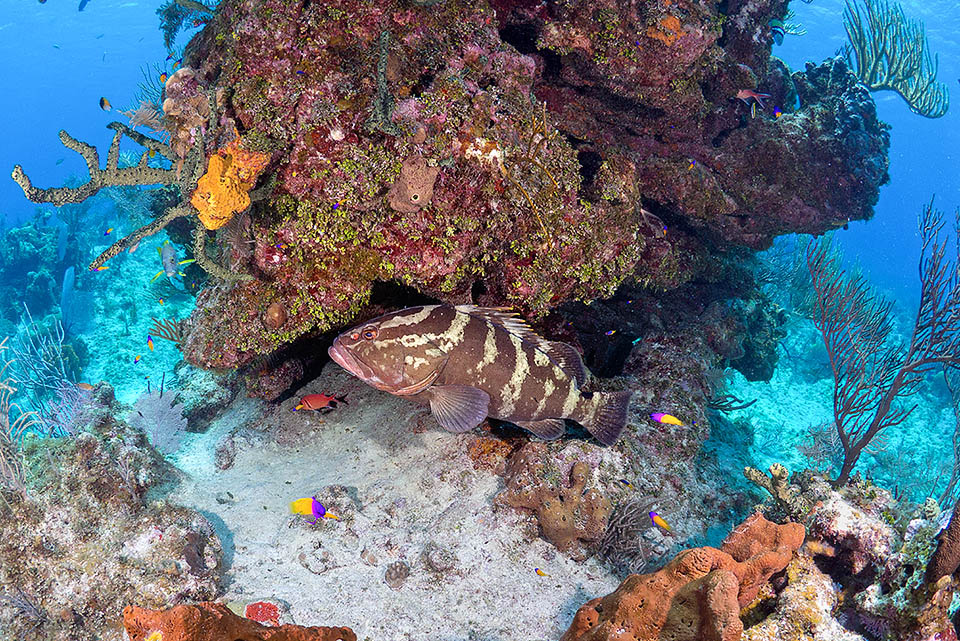
Once even 122 cm long, lives in rocky and madreporic sites in western Atlantic from Bermudas, Florida, Bahamas, Cuba and Caribbean up to southern Brazil © Brian Cole
But if the latter, in return, has been labelled as “VU, Vulnerable” in the IUCN Red List of the endangered species, Epinephelus striatus even appears as “CE, Critically Endangered”, that is very close to extinction.
Zoogeography
The Nassau grouper is present in the western Atlantic from the Bermudas, Florida and Bahamas to Cuba and all the Caribbean up to southern Brazil. Conversely it is lacking in the Gulf of Mexico, but some sites along Yucatan coasts.
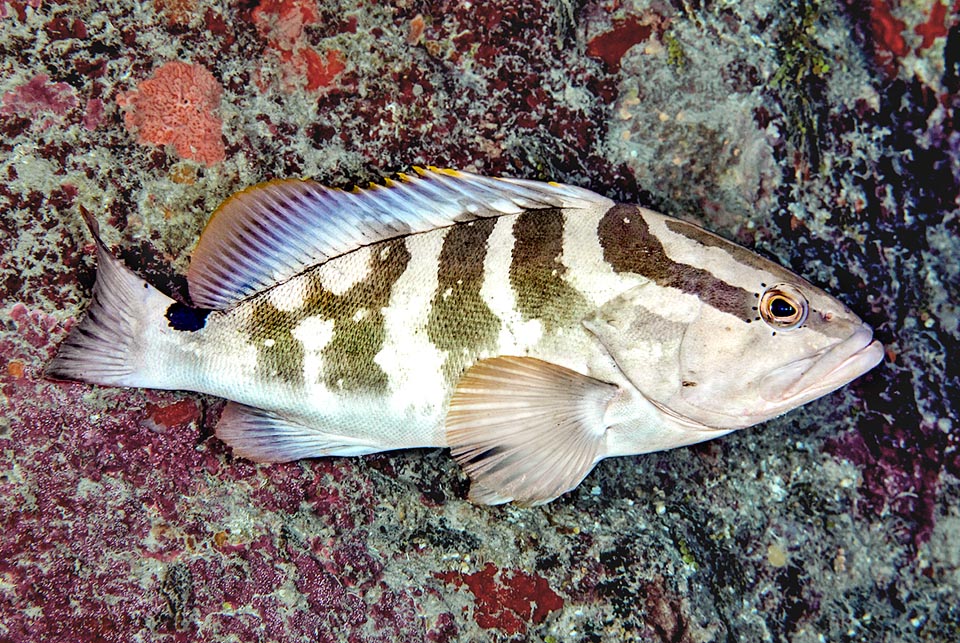
This is typical livery of Nassau grouper with a showy black saddle shaped dot always present on caudal peduncle and dark brown bands. The first, disguising eye, reaches elbowy the beginning of the dorsal fin. Then are 5 irregular vertical bands with the third and fourth forming by touching above a sort of “W” © Allison & Carlos Estape
Ecology-Habitat
Epinephelus striatus is a species associated with rocky and madreporic environments. It lives alone and is often found close to grottoes or under the ridges of the reefs, between 1 m and 90 m of depth, in its hunting territory, where it goes back every year after the huge oceanic movements of the reproductive period. The juveniles grow in the submerged prairies of phanerogams where they go to prey, hidden by the vegetation, up to 12-15 cm in size.
Morphophysiology
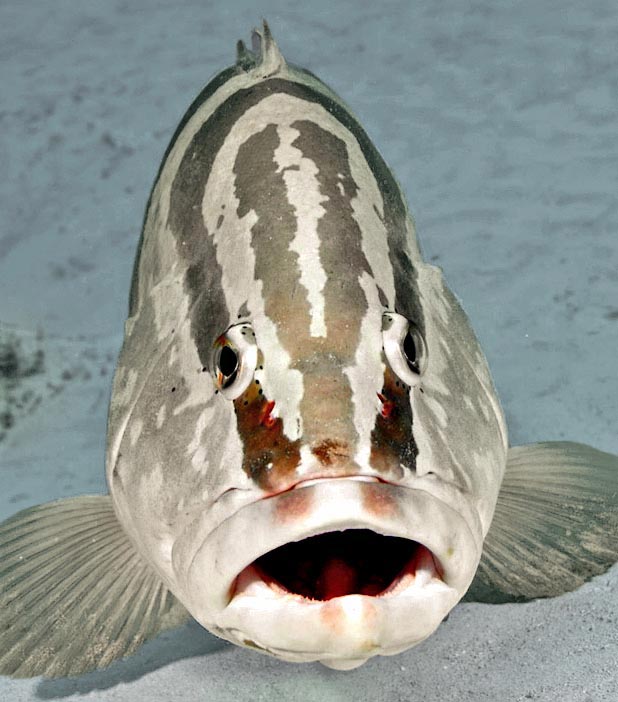
Seen from top we note starting from snout, on the back, the drawing of a bifurcated tuning fork at eyes level © Allison & Carlos Estape
Epinephelus striatus can reach exceptionally 122 cm of length with a weight of about 25 kg, but the catch is usually of about 48 cm.
The body has the typical profile of the groupers with a big protractile mouth that opens suddenly for sucking up the preys alive and the fleshy lips with the protruding lower jaw.
Inside we note bands of small teeth and on the front some sharp canines to hold the victims that have not been swallowed down on the first try.
The eyes, preceded by two nostrils with the back one somewhat bigger, in the shape of a comma, are placed on top of the head, protected by a membrane and camouflaged by by a dark band parallel to the profile of the fish that reaches later, sharply, the beginning of the dorsal fin.
The edge of the preoperculum is slightly serrated and the operculum has three flattened spines.
The ctenoid scales, present also at the base of the dorsal fin and of the anal, are small and overlying.
The dorsal fin, deeply toothed among the spines with the third or the fourth longer, has 12 spiny yellow rays that the fish keeps often bent, and 16-18 soft rays; the anal has 3 spiny rays and 8 unarmed; the pelvic ones 1 spine and 5 soft rays, and the pectoral count 17-19 soft rays.
The caudal fin, truncated in the adults, as usually happens with the groupers, is instead roundish in the juveniles that also have the pelvic fins longer than the pectoral ones.
The background colour, that may change in a few minutes due to the effect of the chromatophores, is mostly beige suede in the individuals living in surface waters, but fades to pinkish in those moving in deep waters where the dark drawings assume orange red hues.
On this extremely changeable basis depending on the mood and the mimetic needs of the fish, we however always note, on the sides, 5 characteristic irregular dark brown vertical bands. They at times have a white dotting, and the third, touching above with the fourth, forms a “W” drawing.
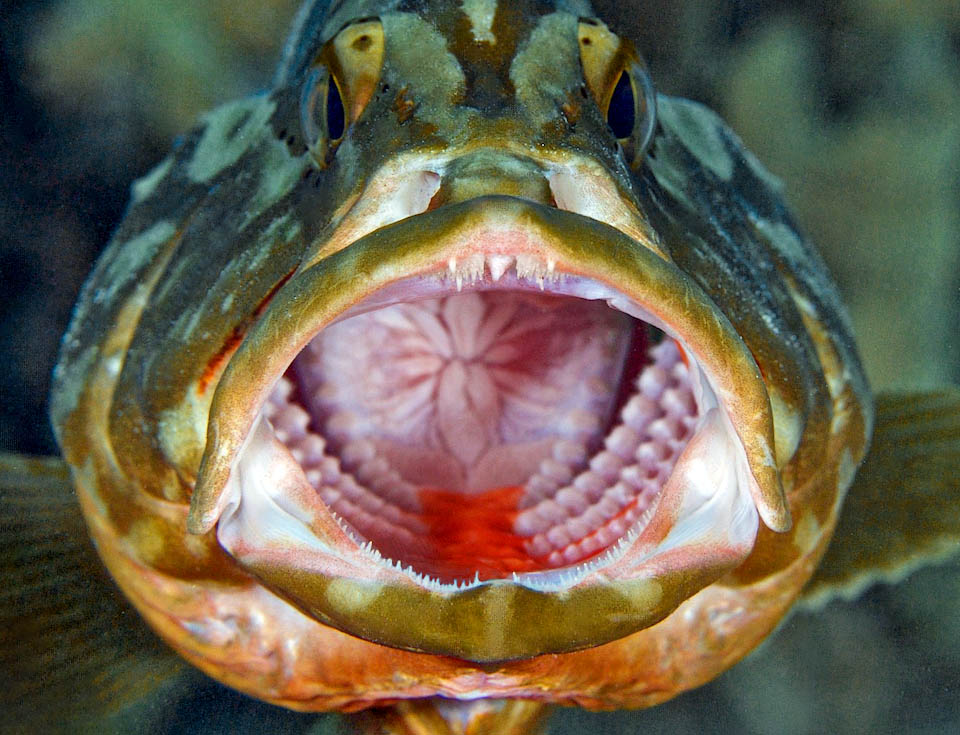
It sucks preys with a protractile mouth. Inside we see bands of small teeth and in front sharp canines for holding victims not swallowed at first try © Allison & Carlos Estape
The black saddle-shaped spot on the caudal peduncle is constant, and observing the fish from above, we note starting from the snout, on the back, the drawing of a bifurcated tuning fork at the level of the eyes. Finally, around these, some typical black dots.
However, in the reproductive gatherings things change dramatically. The Nassau grouper can then present white, dark or bicoloured, with the upper half of the body black including the dorsal fin and a wide white bar that starting from the upper lip through the eye up to the beginning of the dorsal fin, and the whole rest of the body white, including the lower part of the head and the other fins. A livery, this, assumed also in normal times by the weaker fish in the meetings with conspecifics, because it is a sign of good intentions that inhibits the territorial aggressiveness of the species.
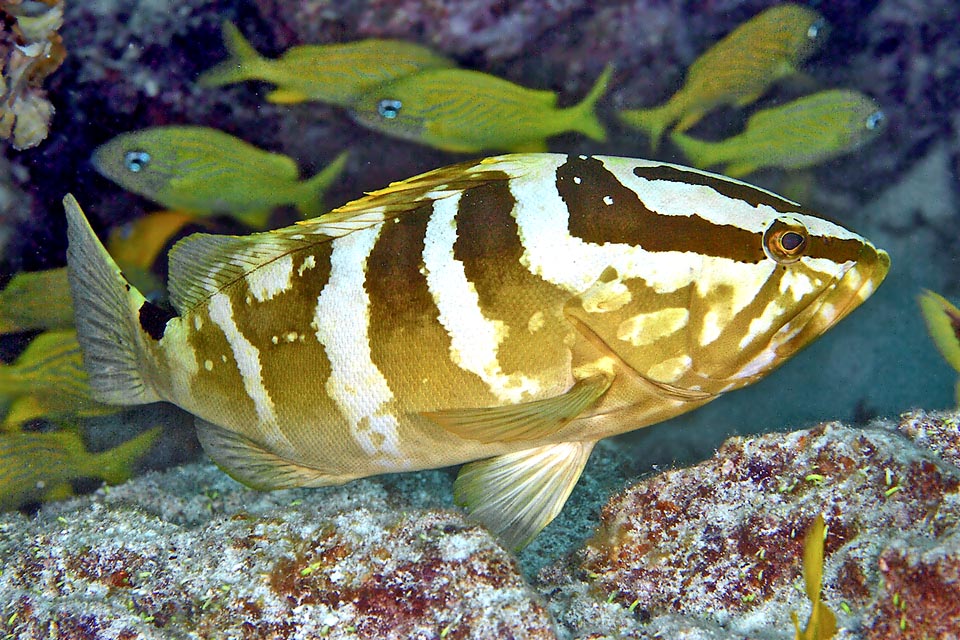
It mainly eats fishes, but also mollusks, like squids, octopuses and gastropods, and crustaceans, mainly lobsters, shrimps and hermit crabs © Allison & Carlos Estape
Ethology-Reproductive Biology
Epinephelus striatus nourishes chiefly of fishes, including relatively big species like Balistes vetula, Caranx ruber, Gymnothorax miliaris or Cephalopholis fulva, but also of mollusks, such as squids, octopuses and gastropods, ad of crustaceans, mainly lobsters, shrimps, hermit crabs and crabs.
The maximum age reported, calculated with the rings of growth of the otoliths, is 29 years, but nowadays, due to the massacres done by the man, it is rare to find specimens more than 16 years old.
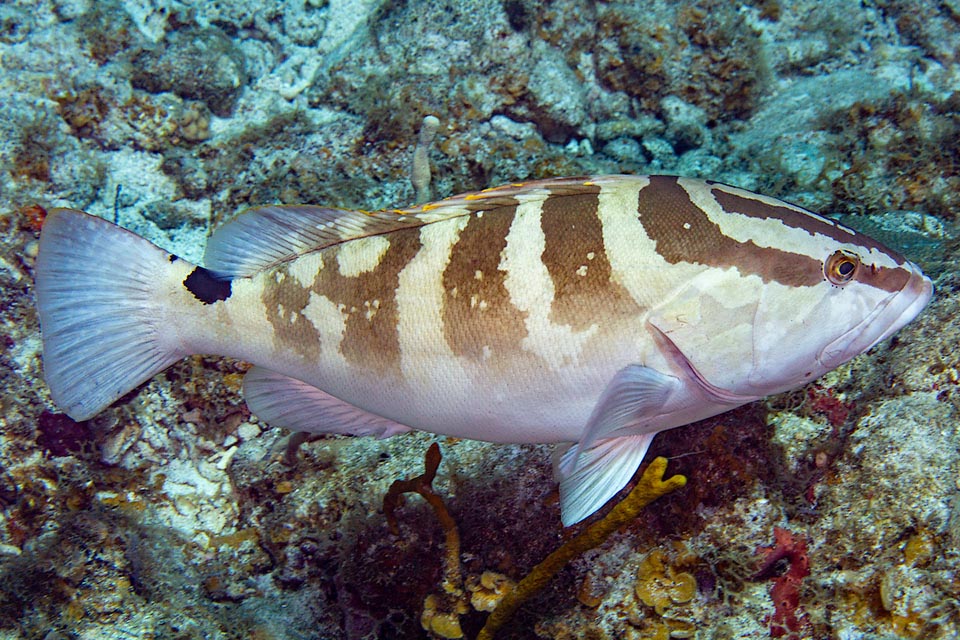
The livery, changeable due to chromatophores after the mood of fish and mimetic needs, is isually paler in the individuals living in shallow waters © Allison & Carlos Estape
The sexual maturity of Epinephelus striatus is reached from 4 to 8 years, and it was discussed whether it was or not a protogynous hermaphrodite species, that is with the transformation of the old females into males frequent in the groupers.
This is possible by treating a female with the hormone injection but the change in nature has not been confirmed. Both sexes in formation are present upon the birth and it has been noted that also small males are circulating.
Therefore the Nassau grouper is mainly gonochoric.
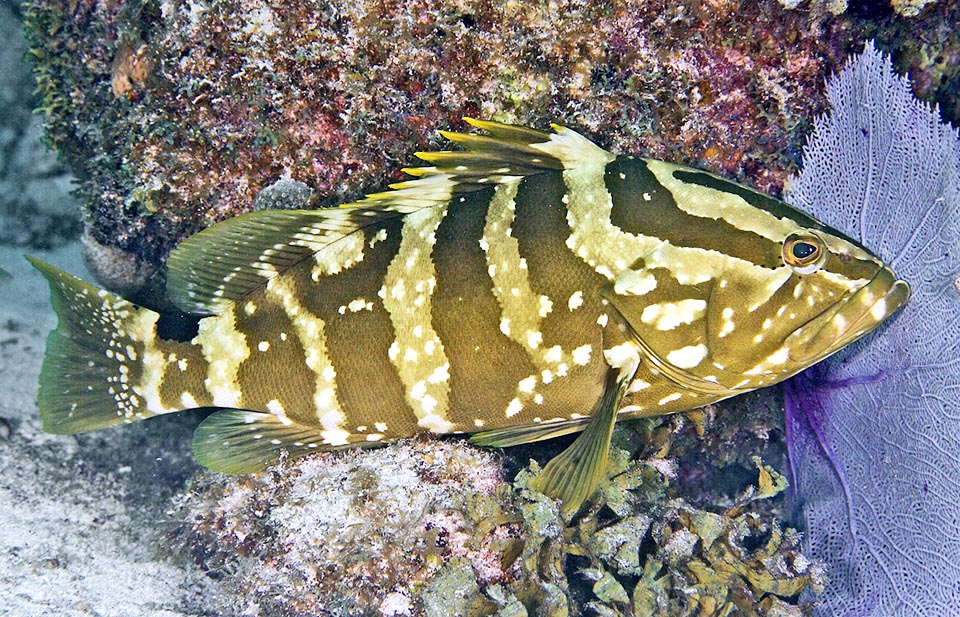
Here looks golden with a more marked drawing. The first part of dorsal fin, often bent, has spiny yellow rays, the third or fourth are the longest © Allison & Carlos Estape
Epinephelus striatus travels for even 250 km to form gatherings of a few weeks in known sites of deposition, like, for instance, in winter at Glover’s Reef off the coast of Belize where once were counted even more than 30.000 individuals and presently, unluckily, they are only a few thousands.
It is not well known what triggers this migration linked like in many fishes to the full moon, but also to the currents and surely to the temperature of the water, so much that the populations resident at higher latitudes such as the Bermudas and Florida gather between May and August.
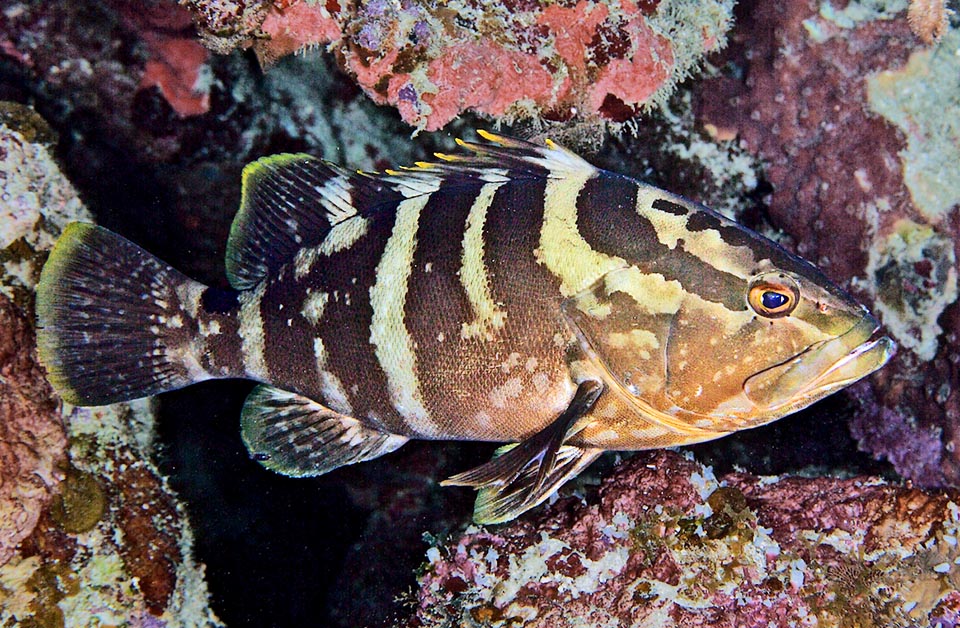
Epinephelus striatus is a fish that can go down up to 90 m sometimes sharing the territory with conspecifics depending the depth © Allison & Carlos Estape
The reproductive aggregations offer undoubtedly many advantages as they reduce the predation of eggs, ince-rease the rate of fecundation and the genetic exchange, but in the meantime increase the predation done by the natural foes and especially by the man who fishing without scruples the predators has now reduced the species to faint.
Aggregations take place at 6-50 m of depth with fertilizations in a column or a cone of water 18-33 m wide.
On the bottom in the morning the fishes with the normal livery prevail, probably not yet ready for reproduction.
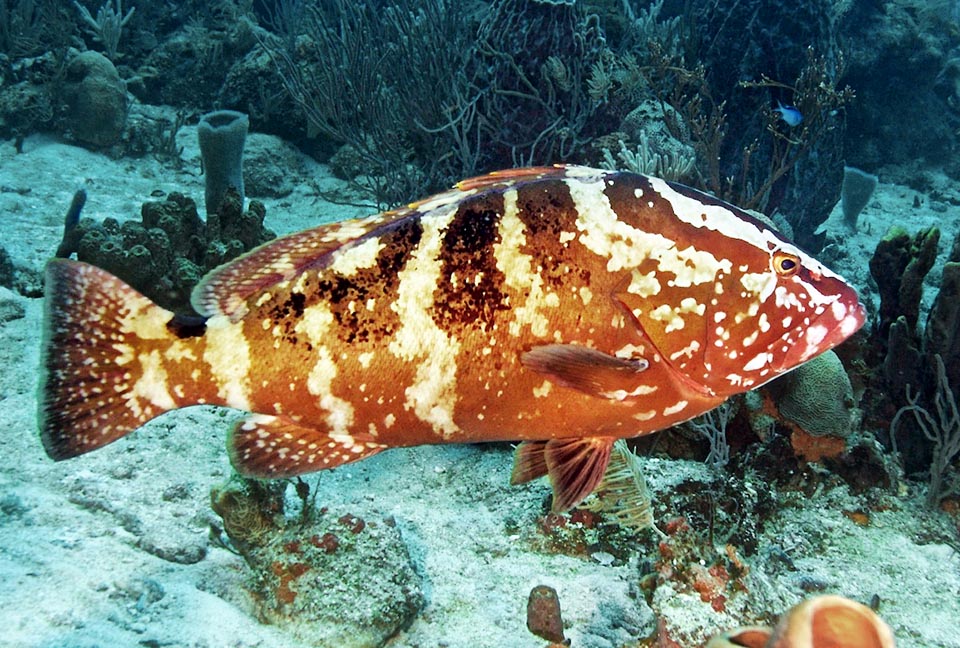
The livery of those moving on the bottom is usually darker with often red or orange red hues © Allison & Carlos Estape
Towards evening they transform mostly in bicoloured fishes, that might be males or females, and white fishes, probably females, if they have the belly swollen of eggs, whilst above, closer to the surface, take position the fishes with dark livery, most probably females.
Matings are preceded by characteristic preliminary signs:spirally vertical swimming in the water column, fast vertical movement without spiral and rapid horizontal run on the bottom. The most important signal, however, the one who opens the group dances, is the short vertical movement of a black fish that suddenly changes direction steering to one side to release the ovules followed by 1-7 excited males who release the gametes.
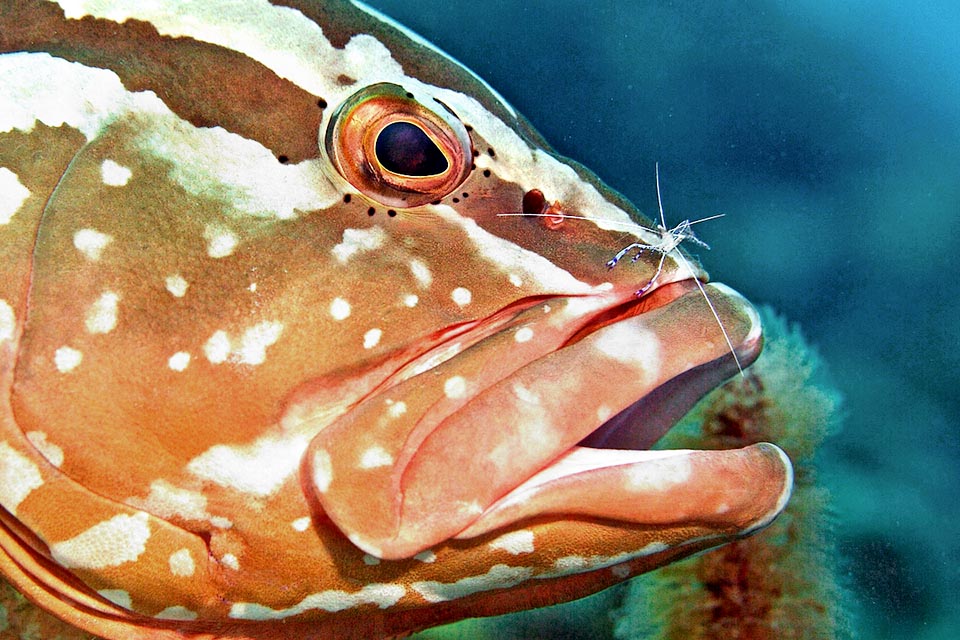
Here with a shrimp, Ancylomenes pedersoni, that takes off skin parasites. To note also the characteristic black dots always present around eyes © Allison & Carlos Estape
Then all go down in a parabolic fashion to the bottom while other excited females follow their example followed by the bicoloured while the last white specimens below do change colour.
It is thought that the drak livery is used by who spawns in. order to be less visible in the dark and therefore less predated. The bicoloured should be a compromise to show the group with the white belly the availability to the party without getting too much noticed from above. The females full of eggs with the white livery are probably individuals very careful but ready to change it, seen that they have reached that far for reproducing.
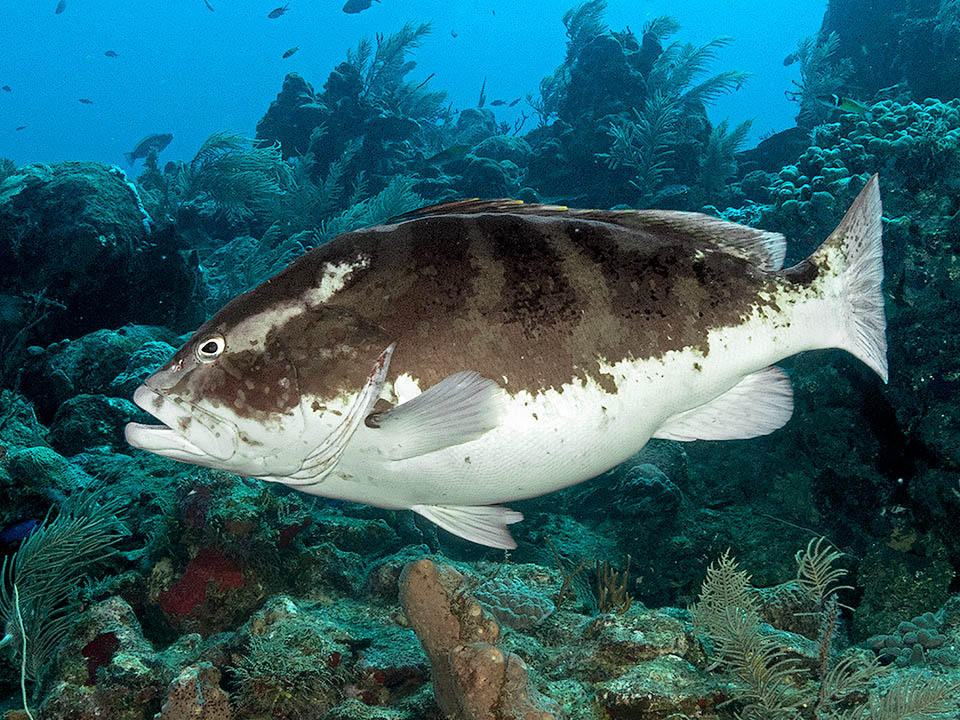
Epinephelus striatus travels even 250 km to form small weeks gatherings in known sites of deposition, like for instance in winter at Glover’s Reef off the Belize coast whare once were counted even 30.000 individuals. For that occasion it displays, besides the normal, a white livery, one dark and one bicoloured like this one © Mickey Charteris
It has been then observed that every year, after the deposition, these groupers return faithfully to their coral barrier, their small and exclusive territory where they spend the rest of the year and it has been discovered that in the same zone may coexist more territories at different depths.
The floating eggs hatch in 23-40 hours, are pelagic like the larvae that starting from 2-4 days feed on zooplankton. After 35-70 days of floating the approach the seabeds to grow in the marine prairies of phanerogams and finally reach the madreporic formations when about 12-15 cm long.
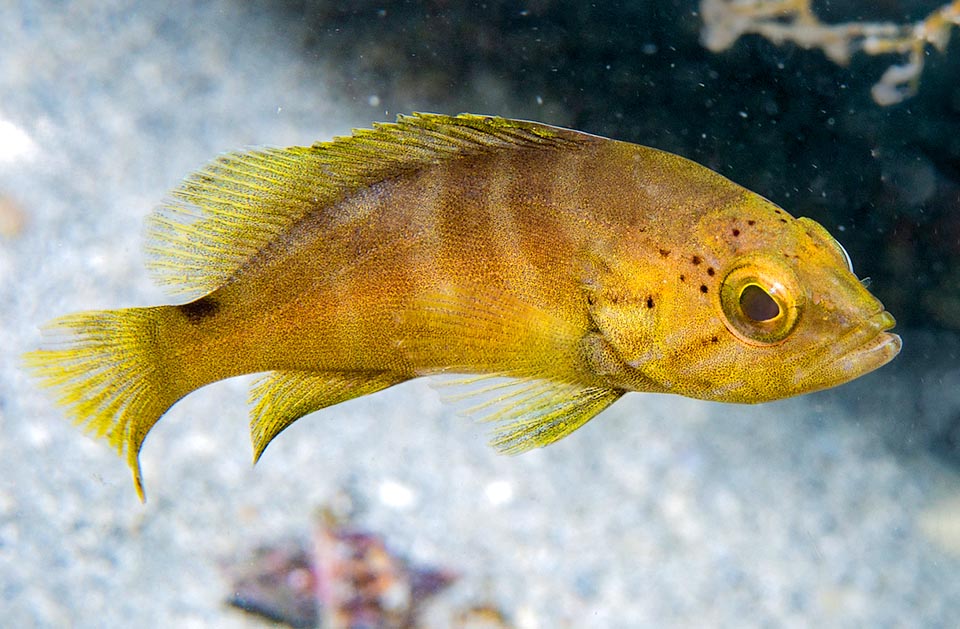
Eggs and larvae are pelagic. Juveniles grow in the phanerogams prairies migrating to madreporic sites when about 12-15 cm long © Allison & Carlos Estape
The resilience of Epinephelus striatus is low, with a minimum time for doubling the populations of 4,5-14 years with pelagic larvae and wandering about one month before reaching, metamorphosing, the submerged prairies. The fishing vulnerability, high, marks 63 on a scale of 100, and during the last 30 years the populations have decreased by 60%.
Presently Epinephelus striatus is protected in the USA and in various locations and they are talking of aquaculture, but there are those thinking that the number of the mature individuals is now too small to guarantee the survival of the species.
Synonyms
Anthias striatus Bloch, 1792; Serranus striatus (Bloch, 1792); Anthias cherna Bloch & Schneider, 1801; Sparus chrysomelanus Lacepède, 1802; Serranus gymnopareius Valenciennes, 1828.
→ For general information about FISH please click here.
→ For general information about BONY FISH please click here
→ For general information about CARTILAGINOUS FISH please click here.
→ To appreciate the BIODIVERSITY of BONY FISH please click here.
→ To appreciate the BIODIVERSITY of CARTILAGINOUS FISH please click here.
